Ultrananaotech, ULTRANANOTECH
STICK TO THE FUTURE: THE POWER OF SILVER EPOXY
INTRODUCTION
Epoxy refers to a type of chemical compound that consists of an epoxide group, which is a three-membered ring containing an oxygen atom. This group is highly reactive, allowing epoxy compounds to form strong bonds with various materials/ substrates.
In a broader sense, epoxy refers to a family of thermosetting polymers that are formed by the reaction of epoxide groups with other chemicals, such as amines, acids, or alcohols. ( Cross linked)
SILVER CONDUCTIVE EPOXY:
Silver conductive epoxy is a type of adhesive that combines the high conductivity of silver with the strong bonding properties of epoxy. It’s widely used in electronics and electrical applications for making connection.
Silver epoxy adhesives (ECAs) have been widely used in semiconductor and electronic packaging industries since the 1960s, as a reliable connection method instead of soldering or eutectic joining of metals.
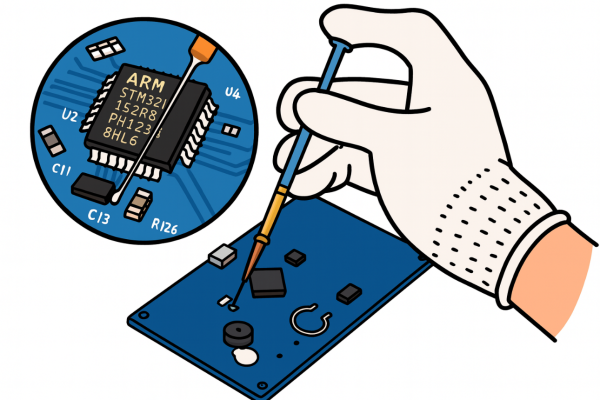
Fig: Representation of the connection silver epoxy in a circuit.
FUNCTIONING OF SILVER EPOXY
To understand silver epoxy, let’s break it down into its components and properties:
COMPONENTS:
- Epoxy resin (A): A thermosetting polymer that provides strong bonding and durability.
- Hardener (B): A chemical that reacts with the epoxy resin to form crosslinking strong bond.
- Silver filler: Metallic silver particles or flakes that add conductivity and other properties.
- Hardener (B): A chemical that reacts with the epoxy resin to form a strong bond.
- Solvents (optional): Chemicals that thin out the epoxy for easier application.
- Additives (optional): Chemicals that enhance specific properties, like flexibility or UV resistance.
PROPERTIES:
- Conductivity: Silver epoxy conducts electricity due to the conducting silver filler.
- Adhesion: Epoxy has strong bonding to various substrates, like metals, ceramics, and plastics.
- Chemical resistance: Resistant to chemicals, solvents, and harsh environments.
- Flexibility: Can be formulated to be flexible or rigid.
TWO COMPONENT SYSTEM:
THE MIX RATIO: 100 (Part A) to 50 (Part B) by weight.
A two-component (2C) system for silver conductive epoxy:
PART A: SMOOTH SILVER PASTE
- Composition: Silver filler (70-90%), epoxy resin, and other additives
Properties:
- High silver content for excellent electrical conductivity
- Smooth paste consistency for easy mixing and application
- Low viscosity for good flowability
- Function: Provides the primary conductive pathway.
PART B: SMOOTH SILVER PASTE (HARDENER)
- Composition: Epoxy hardener, silver filler (optional), and other additives
Properties:
- Reacts with Part A to initiate curing
- Smooth paste consistency for easy mixing and application
- Compatible with Part A to form a strong bond
- Function: Reacts with Part A to cross-link and cure the epoxy
CURING MAIN PARAMETER OF SILVER CONDUCTIVE EPOXY:
Curing time refers to the duration required for an epoxy to fully harden and attain its optimal properties. This critical process, influenced by factors such as epoxy type, temperature, thickness, and formulation, can range from a few minutes to several hours or even days. Incorrect curing times can lead to incomplete curing, reduced mechanical strength, poor adhesion, increased brittleness, and decreased chemical resistance.
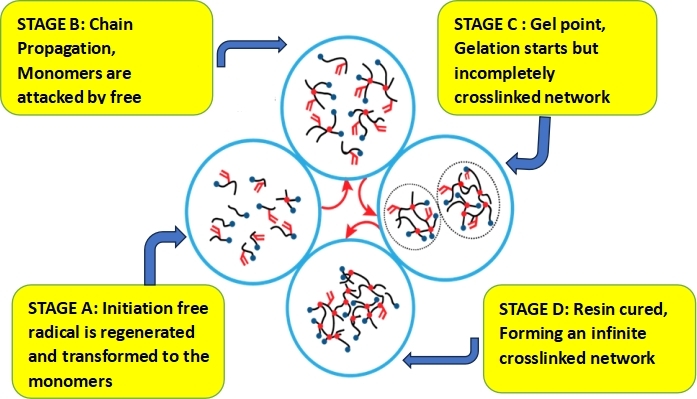
Fig: Curing mechanism of silver epoxy
AREAS WHERE SILVER CONDUCTIVE EPOXY CAN BE USED
SEMI CONDUCTING & SCREENPRINTING
It is used for die attach, wire bonding, flip chip attachment, heat sink attachment, electrical interconnections, shielding, and underfill applications. Silver epoxy provides reliable electrical connections, robust bonding, and withstands high temperatures, making it an ideal material for semiconductor packaging. Its benefits include improved reliability, increased performance, reduced costs, enhanced thermal management, and miniaturization, enabling the creation of compact and high-performance electronic devices.
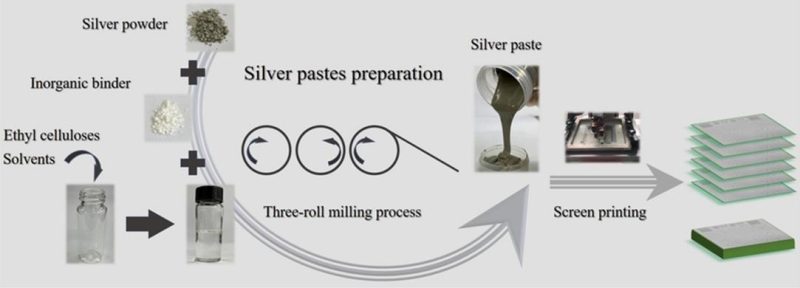
Fig: Scheme represents the silver epoxy has been used in screen Printing
SOLUTIONS FOR IC DIE ATTACH:
Die attach is a very important step in the packaging process. The main purpose of die attach is to grab a single chip from the cut wafer and place it on the substrate.
The main process is shown in the following figure, which can be divided into three
The main components of silver adhesive are epoxy resin, silver powder and a small amount of additives. Epoxy resin and additives play the role of bonding, while silver powder mainly plays the role of heat conduction. The finished silver glue is installed in the syringe and stored at – 40 ℃ to prevent denaturation. Before use, take out the silver glue and return it to temperature, mix it evenly in the centrifugal mixer, and extrude the bubbles in it.
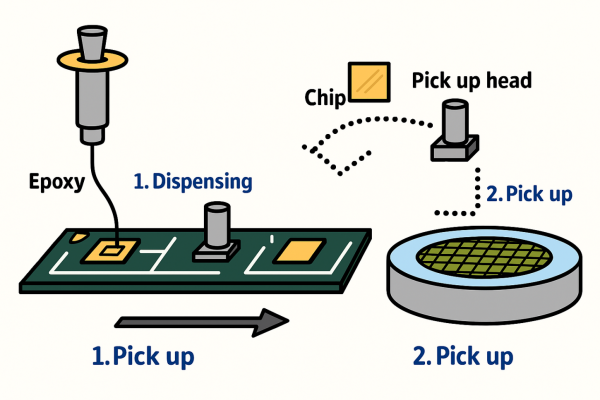
Fig: Application of Silver epoxy in Printing Chips
APPLICATION OF SILVER EPOXY
- Nano-electronics: Silver epoxy is used as a conductive adhesive to connect nano-scale components, such as nanoparticles, nanowires, and nano-devices.
- Nano-sensors: Silver epoxy is used to fabricate nano-sensors, such as biosensors, chemical sensors, and physical sensors, due to its high conductivity and sensitivity.
- Nano-assembly: Silver epoxy is used to assemble nano-components, such as nanoparticles, nanotubes, and nano-wires, into functional devices.
- Nano-coating: Silver epoxy is used as a coating material to provide conductivity, corrosion resistance, and biocompatibility to nano-surfaces.
- Nano-bio interface: Silver epoxy is used to create nano-bio interfaces for biomedical applications, such as implantable devices, biosensors, and drug delivery systems.
- Nano-energy storage: Silver epoxy is used to fabricate nano-energy storage devices, such as supercapacitors and batteries, due to its high conductivity and electrochemical stability.
- Nano-photonics: Silver epoxy is used to create nano-photonic devices, such as optical interconnects, waveguides, and nano-lasers.
FUTURE PROSPECTS OF SILVER EPOXY:
– Increasing demand for high-performance materials
– Growing applications in emerging technologies (e.g., 5G, IoT, and renewable energy)
– Continuous improvement in formulation and Electronics processing techniques.
In summary, silver epoxy is a highly conductive and reliable material that offers a range of benefits and applications. Its unique properties and versatility make it an essential material for various industries, and its future prospects look promising
CONCLUSION:
By utilizing silver epoxy in nano applications, researchers and manufacturers can create innovative devices and systems with enhanced performance, functionality, and reliability. silver epoxy is a versatile and highly conductive adhesive material that offers a range of benefits and applications.
Opportunities lie in emerging applications, such as flexible electronics, quantum computing, and biomedical implants. Addressing these challenges and capitalizing on opportunities will shape the future of silver epoxy.
Courtesy of: Reashvanth, Technical Executive at ULTRANANOTECH PVT LTD
 +91-8800903073, 8452810712
+91-8800903073, 8452810712
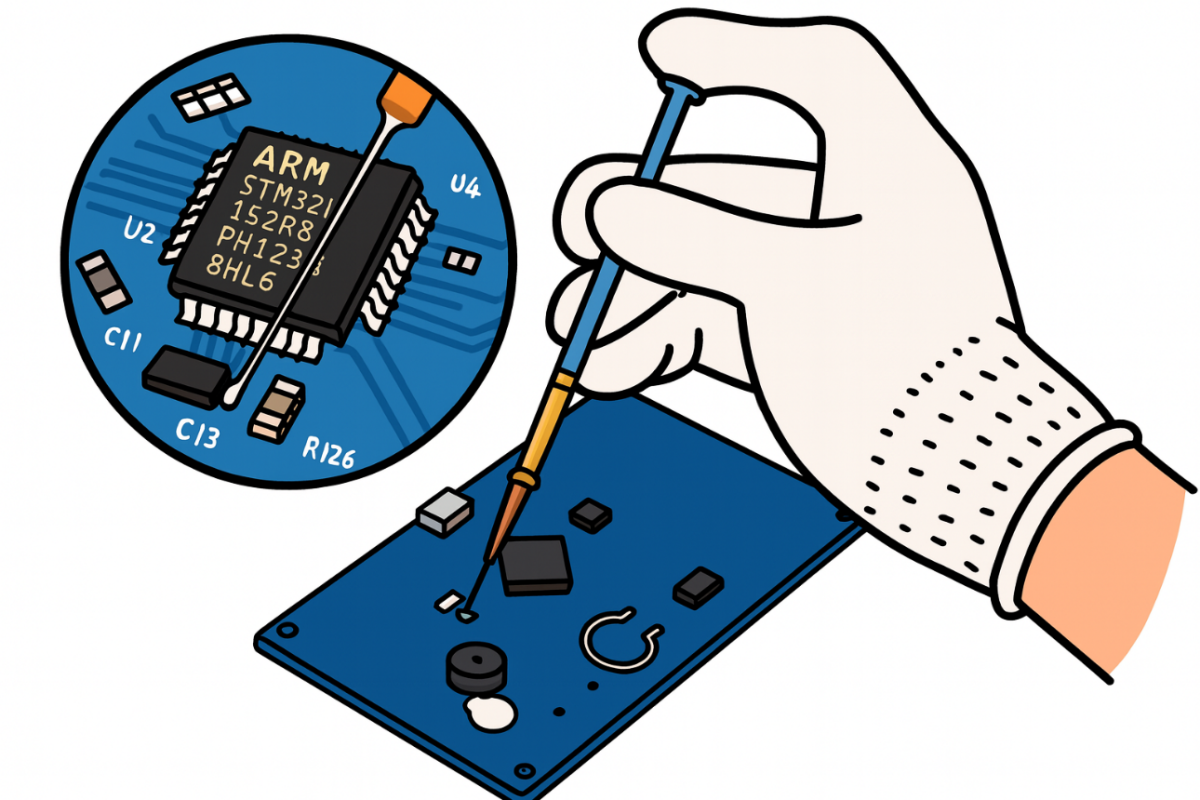
Very good
Awesome